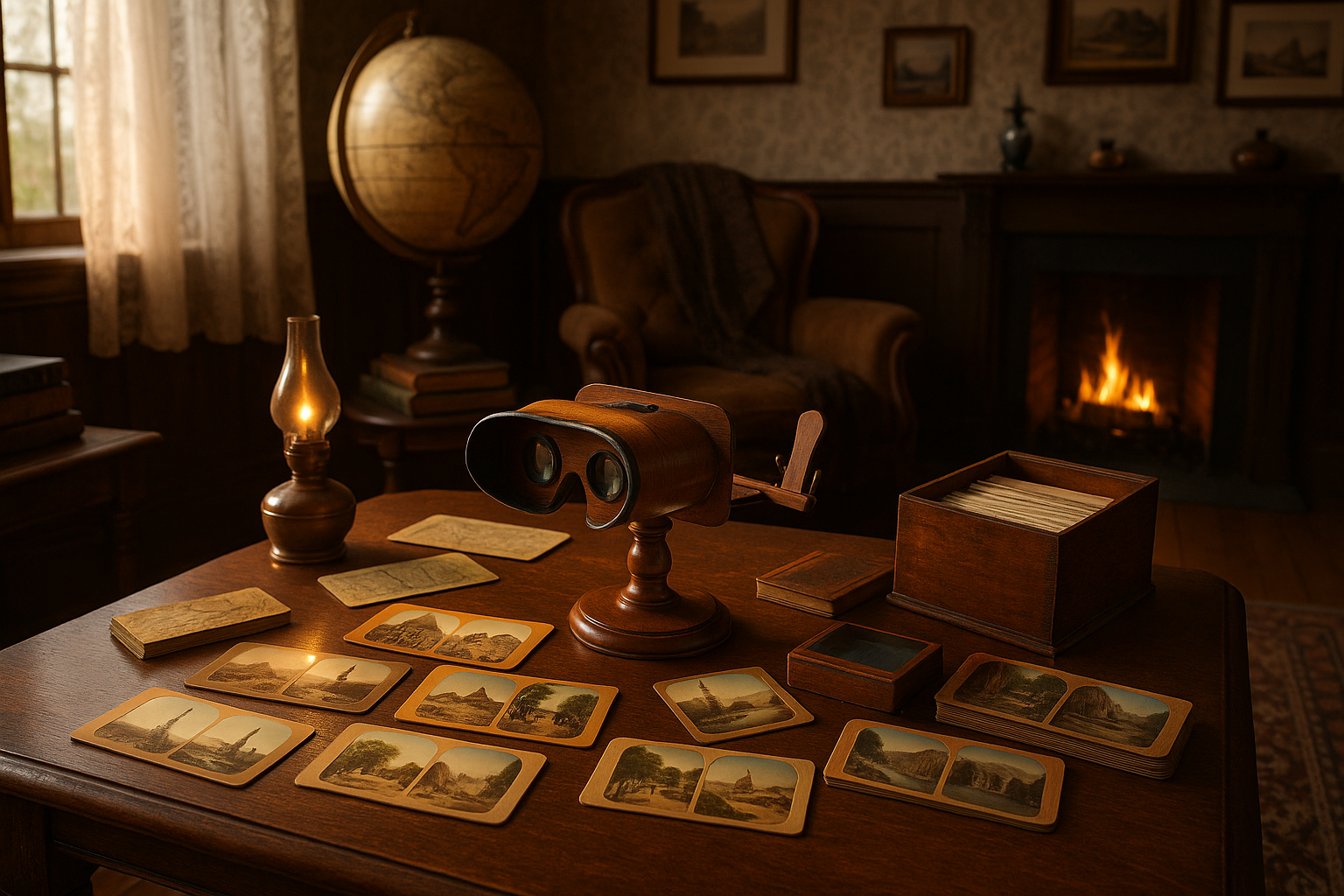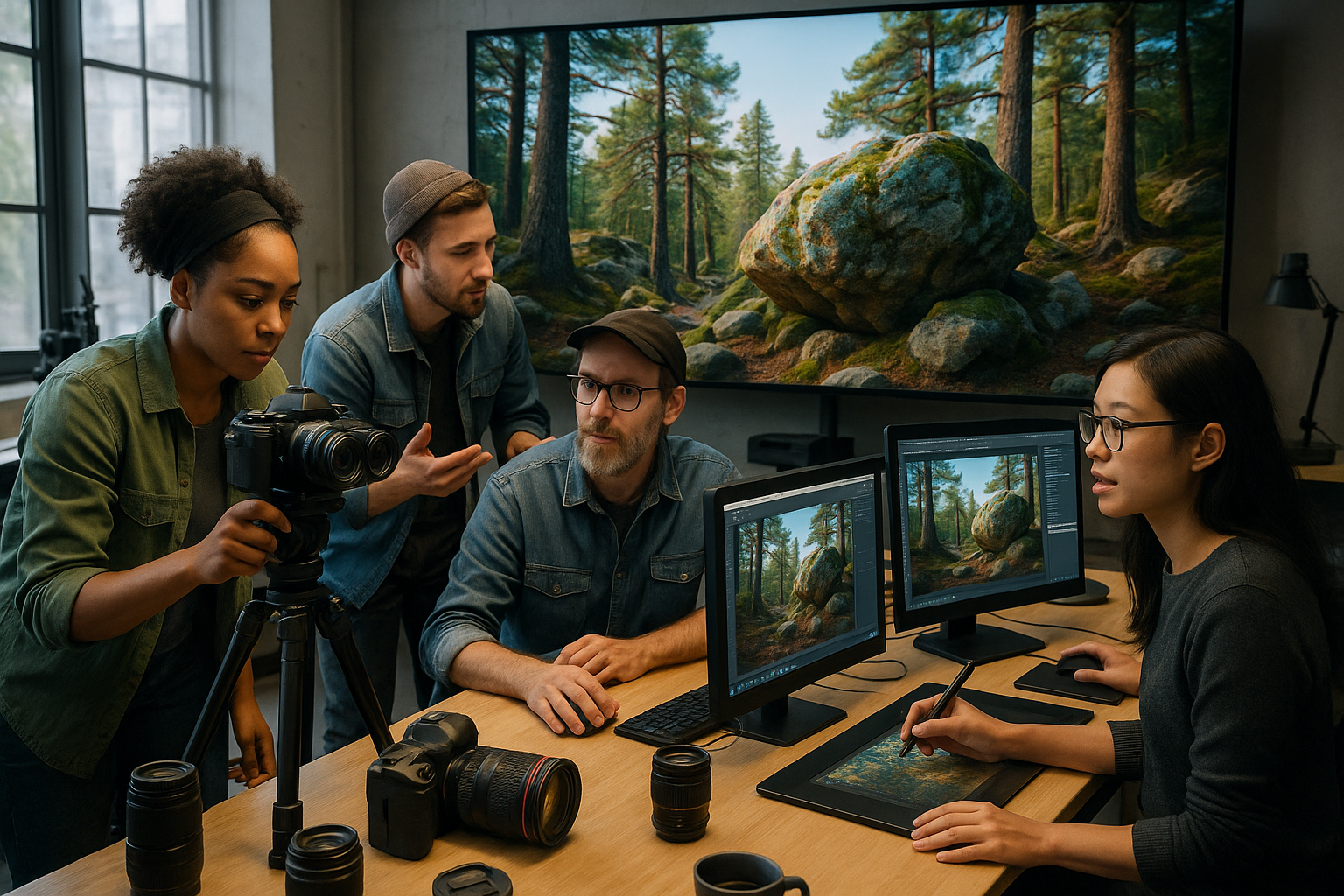In a world where visuals dominate our daily lives, the power of images has never been more influential. From the billboards towering over city streets to the endless scroll of social media feeds, captivating imagery is the heartbeat of modern advertising. But as technology advances, so do the techniques used to capture the attention and imagination of audiences. Enter the realm of 3D vision and the fascinating world of stereographs—a groundbreaking approach that is revolutionizing how we perceive and interact with advertisements. With its roots deeply embedded in the 19th century, the stereograph is making a remarkable comeback, harnessing contemporary technology to create immersive experiences that leave a lasting impact. 🌟
In this article, we’ll embark on a journey through the evolution of 3D vision in advertising, exploring how stereographs have transitioned from Victorian parlor entertainment to a powerful tool in today’s digital marketing arsenal. We’ll delve into the science behind stereoscopic imagery, unraveling how the brain processes these visuals to create a sense of depth and realism that two-dimensional images simply cannot achieve. Alongside this exploration, we’ll examine case studies of brands that have successfully integrated stereographs into their advertising strategies, highlighting the creative and commercial benefits they’ve reaped. By the end, you’ll have a comprehensive understanding of how this technology is not only enhancing visual storytelling but also transforming consumer engagement and brand perception.
Moreover, we’ll touch upon the challenges and considerations marketers face when incorporating 3D vision into their campaigns. From the technical complexities of producing high-quality stereoscopic content to the psychological nuances of audience reception, navigating this innovative landscape requires a keen understanding of both artistry and analytics. Whether you’re a seasoned marketer seeking to elevate your brand’s visual impact or a curious reader intrigued by the fusion of art and technology, this article will equip you with valuable insights into the transformative power of stereographs in advertising. Prepare to see the world of marketing through a new lens—one that adds depth, dimension, and dynamism to the ever-evolving narrative of visual communication. 🌀
The Evolution of 3D Vision in Advertising
The world of advertising has always thrived on innovation, consistently pushing the boundaries to capture consumer attention in increasingly dynamic ways. One such innovation is the use of 3D vision, particularly through stereographs, to create immersive advertising experiences. Stereographs, which date back to the 19th century, have been revitalized in the digital age, offering a unique avenue for brands to engage audiences. This technology leverages the human visual system to create the illusion of depth, transforming traditional advertising into a three-dimensional experience. In this section, we explore how 3D vision has evolved over time and its implications for modern advertising.
Initially, stereographs were created using two photographs of the same object taken from slightly different angles, which were then viewed through a stereoscope to create a 3D effect. These devices were popular in the late 1800s and early 1900s, allowing people to view images with a sense of depth that was unprecedented at the time. Fast forward to today, and technology has dramatically advanced, with digital stereographs offering more vivid and interactive experiences. Advertisers now utilize these to create virtual reality (VR) and augmented reality (AR) campaigns that fully immerse the viewer, thereby increasing engagement and recall.
3D vision technology has not only become more accessible but also more sophisticated. Modern advertising campaigns frequently use this technology to create captivating content that stands out in a crowded media landscape. The ability to manipulate depth perception allows advertisers to highlight product features and create narratives that resonate more deeply with viewers. This approach goes beyond traditional advertising methods by engaging multiple senses and fostering a more interactive consumer experience.
The Science Behind Stereographs
Understanding the science of stereographs is essential to appreciate their effectiveness in advertising. At its core, 3D vision relies on binocular vision, where each eye captures a slightly different image. The brain processes these two images to create a single, cohesive picture with depth, allowing us to perceive the world in three dimensions. Stereographs exploit this by presenting two offset images, one for each eye, to simulate this natural depth perception.
Advancements in digital technology have enhanced this process, making it possible to create more complex and realistic 3D images. Software can now simulate the subtle variations in perspective needed to produce convincing depth, while hardware like VR headsets provides the necessary means to view these images in their intended form. This combination of technology and psychology forms the foundation of modern 3D advertising.
To see how stereographs are applied in advertising, check out the video below:
3D Advertising Explained – Channel: TechVision
Applications of 3D Vision in Modern Advertising
With the foundational understanding of stereographs and their capabilities, it’s crucial to explore the various applications of 3D vision in the modern advertising landscape. Today, advertisers use this technology to enhance storytelling, improve brand recall, and create memorable consumer interactions. Whether through augmented reality apps, virtual reality experiences, or interactive web content, the possibilities are vast and continually expanding.
Augmented reality, for instance, allows consumers to see products in their own environment before making a purchase, reducing the uncertainty associated with online shopping. This application is particularly useful in industries like furniture and home decor, where spatial visualization is crucial. Similarly, virtual reality offers fully immersive experiences that can transport consumers to different worlds, making it ideal for brand storytelling and experiential marketing campaigns.
Interactive web content is another burgeoning area where 3D vision is making waves. Brands can create web-based experiences that allow users to interact with products in a virtual space, offering a level of engagement that static images or videos cannot achieve. This form of advertising not only captivates the audience but also provides valuable data on consumer preferences and behaviors.
Benefits of 3D Vision in Advertising
The advantages of incorporating 3D vision into advertising strategies are multifaceted. Here are some key benefits:
- Enhanced Engagement: 3D advertising captures attention more effectively than traditional methods, increasing the likelihood of consumer interaction.
- Improved Recall: The immersive nature of 3D experiences helps consumers remember brands and products more vividly.
- Better Storytelling: 3D technology allows for richer narratives that resonate emotionally with audiences.
- Increased Conversion Rates: By providing a more comprehensive view of products, 3D advertising can lead to higher purchase intent and conversion rates.
These benefits illustrate why more brands are investing in 3D technology as part of their advertising arsenal. As this trend continues, it will likely reshape the advertising industry, setting new standards for creativity and consumer engagement.
Challenges and Considerations in 3D Advertising
While the benefits of 3D vision in advertising are substantial, there are also challenges and considerations that brands must navigate to effectively leverage this technology. Cost is one of the primary concerns, as developing high-quality 3D content can be resource-intensive, requiring specialized skills and equipment. However, as technology advances and becomes more affordable, these costs are expected to decrease, making 3D advertising more accessible to a broader range of businesses.
Another consideration is the technological barrier to entry for consumers. While devices like VR headsets provide an optimal viewing experience, they are not yet ubiquitous. This means that brands must carefully consider their target audience and the platforms they use to ensure that their 3D content reaches the intended viewers. Additionally, ensuring compatibility across different devices and platforms is crucial for providing a seamless user experience.
Finally, there is the question of content quality. With 3D advertising, the quality of the content is paramount, as poor execution can detract from the user experience and harm brand reputation. Brands must invest in creating high-quality, realistic 3D content that aligns with their brand message and resonates with their audience. This requires collaboration between creative teams, technologists, and marketers to achieve the desired outcome.
Table: Cost vs. Benefits of 3D Advertising
To weigh the costs against the benefits, consider the following table:
| Aspect | Costs | Benefits |
|---|---|---|
| Development | High initial investment for content creation and technology | Enhanced engagement and interaction |
| Technology | Requires specific devices and platforms | Provides immersive experiences |
| Reach | Limited by consumer access to technology | Potential for viral reach through interactive content |
Understanding these challenges and planning accordingly can help brands successfully implement 3D vision in their advertising strategies, ultimately reaping the benefits of this innovative technology.

Conclusion
In conclusion, the exploration of 3D vision and the use of stereographs in advertising provides us with a rich tapestry of historical, technological, and psychological insights. We delved into the origins of stereography, tracing its roots back to the early days of visual media, where it captured the imagination of audiences with its novel depth and realism. This historical perspective is crucial, as it helps us understand how the fascination with 3D imagery has evolved and adapted over time, influencing and being influenced by the technological advancements of each era.
We then examined the technological aspects of 3D vision, exploring how modern techniques have refined and expanded the capabilities of stereographic imagery. Advances in digital technology have not only resurrected the traditional appeal of stereographs but have also revolutionized the way they are produced and consumed. From VR headsets to augmented reality applications, the fusion of 3D vision with cutting-edge technology offers unprecedented opportunities for engagement and interaction in advertising. These innovations provide a more immersive experience, allowing consumers to connect with brands on a more profound level.
Psychologically, 3D advertising taps into the human brain’s natural propensity for depth perception and spatial awareness, enhancing memory retention and emotional engagement. The brain’s ability to perceive and process three-dimensional stimuli creates a more memorable and impactful experience for the viewer, often translating into a stronger brand recall and influence on purchasing decisions. This intersection of psychology and technology underscores the power of 3D advertising as a tool for marketers aiming to captivate and persuade.
Moreover, we discussed the versatility of 3D advertising across various industries, from entertainment and real estate to education and healthcare. The adaptability of stereographic techniques allows for creative and innovative campaigns that can cater to diverse audiences and objectives. This flexibility not only broadens the scope of 3D advertising but also ensures its relevance in a rapidly changing digital landscape.
The importance of 3D vision and stereographs in advertising cannot be overstated. As consumer expectations evolve and the demand for engaging content grows, marketers must harness the potential of these techniques to stay competitive and relevant. By integrating 3D vision into their strategies, brands can offer unique experiences that stand out in a crowded marketplace, fostering deeper connections with their audiences.
As we look to the future, the possibilities for 3D advertising continue to expand. Emerging technologies such as AI and machine learning hold the promise of further personalizing and enhancing 3D experiences, making them even more compelling and effective. The ongoing development of new tools and platforms will likely drive the next wave of innovation in this field, opening up new avenues for creativity and impact.
In light of these insights, we encourage you, our readers, to consider how the principles of 3D vision and stereographic advertising can be applied within your own contexts. Whether you’re a marketer, a content creator, or simply an enthusiast of visual media, the potential applications are vast and varied. Share your thoughts and experiences in the comments below, and let’s continue the conversation about how we can leverage these exciting techniques to create more engaging and effective communications.
Feel free to share this article with your network if you found it insightful, and don’t hesitate to reach out if you have any questions or need further information. Together, we can explore the power of 3D vision in advertising and unlock new possibilities for innovation and engagement. 🌟
For further reading, you can explore resources such as the Smithsonian Institution’s Collection on Stereographs, which offers a wealth of historical context and imagery, or visit the 3D Media Center for insights into the latest technological advancements in 3D imagery. These sources can provide additional depth and understanding, enhancing your appreciation of the fascinating world of 3D vision in advertising.
Toni Santos is a visual historian and artisan whose creative lens is captivated by the forgotten marvels of antique optical devices. Through his thoughtful storytelling, Toni revives the instruments that once transformed light into wonder—camera obscuras, magic lanterns, kaleidoscopes, and other ingenious tools that shaped our earliest visual imaginations.
His journey is rooted in a fascination with how humans have long sought to bend, reflect, and reveal the unseen. Whether tracing the mechanical poetry of 19th-century projectors or illustrating the tactile elegance of early lenses, Toni’s work invites us to see vision itself as an evolving art form.
Blending handcrafted design with historical inquiry, Toni brings to life the material soul of these devices—celebrating not just how they functioned, but what they meant. His creations and curated stories illuminate a world where science, illusion, and beauty were intricately linked through glass and brass.
As the curator of Vizovex, Toni shares detailed studies, reconstructed artifacts, and immersive content that help others rediscover the origins of visual technology and the magic of analog perception.
His work is a tribute to:
The craftsmanship behind early visual instruments
The wonder of seeing through the eyes of another century
The intersection of optics, art, and imagination
Whether you’re a collector, a designer, or someone drawn to the lost poetry of vision, Toni welcomes you into a world where light is a storyteller—one prism, one lens, one forgotten invention at a time.





